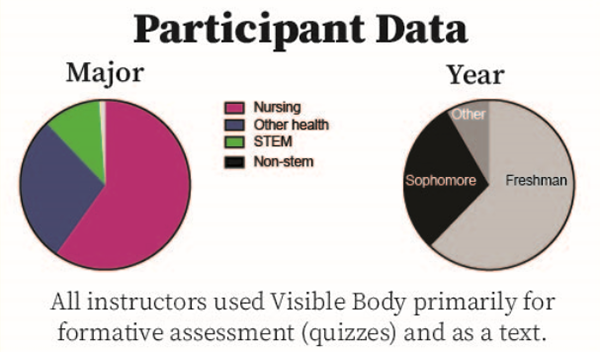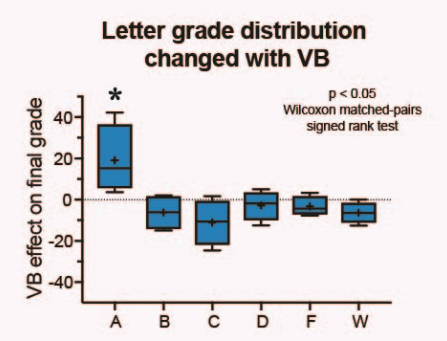Visible Body Improves Student Performance: HAPS 2021 with Dr. Cindy Harley
Posted on 6/4/21 by Laura Snider
The HAPS Annual Conference provides a great opportunity for anatomy instructors to network and share teaching resources and research. This year, Visible Body was featured in one of the studies presented at HAPS 2021! Dr. Cindy Harley of Metropolitan State University presented a poster detailing her research and was kind enough to share both the poster and the results of the study with us.
Cindy gave a VB Webinar a while back about how she saw an improvement in her own students’ grades after switching from a textbook to Visible Body. She wanted to find out if other instructors were seeing the same sorts of changes to their own students’ grades, so she reached out to colleagues at five institutions and gathered some data with a survey! Let’s take a look at the results.
You can watch the video of Cindy's presentation below, but we've also summarized the results of her study in this blog post.
Study methods and participants
Five instructors at five different institutions participated in the survey and provided data about the courses they taught before and after adopting Visible Body. Data collected in the survey included students’ final grades, descriptive details about grading and content delivery methods, and Likert scale ratings of instructors’ experiences and perception of student success using Visible Body. The instructors at each institution used Visible Body in a similar way—for formative assessments (low-stakes assignments like quizzes) and as a replacement for or supplement to the course’s textbook.
Though class size ranged from 10 to 200 students, the study included data from 382 students in total, 362 of whom used Visible Body. Interestingly, most of the students in the study (more than 75%) were part-time students, meaning that they likely had to balance their academic work with other responsibilities.
 Image used with permission from Dr. Cindy Harley.
Image used with permission from Dr. Cindy Harley.
The majority of students were either nursing majors or other health science or STEM majors. They also tended to be at the beginning of their academic journey—more than 50% were freshmen and around 25% were in their sophomore year. The institutions involved in this study all had 31% or more Pell grant eligible students, indicating that many students at these schools likely came from low SES backgrounds.
 Image used with permission from Dr. Cindy Harley.
Image used with permission from Dr. Cindy Harley.
Results and conclusions
Overall, the results of the survey were encouraging and exciting for the future of app-based A&P teaching. Mean and median grades at all sites were higher, and fewer students withdrew from courses when instructors taught with Visible Body.
19% more students got As
One of the most impressive results from this study is that 19% more students received As! As you can see in the figure below, that’s not only a sizable increase in As but a statistically significant one as well.
 Image used with permission from Dr. Cindy Harley.
Image used with permission from Dr. Cindy Harley.
What’s more, the 6% drop in Bs alone can’t account for these additional As, meaning that some students who had Cs (an 11% drop in Cs) must have also moved into the A category.
Grades went up 6.65% on average
There weren’t just more students getting As—grades overall went up when instructors used VB. The median grade across all institutions increased by around 4%. The average increase in mean grade across all institutions was 6.65%. As shown in the set of graphs below, the mean and median grades increased everywhere. The increase in mean grade was statistically significant at three out of the five institutions.
 Image used with permission from Dr. Cindy Harley.
Image used with permission from Dr. Cindy Harley.
One potential reason Cindy suggested for why VB helped bring up grades was its affordability. Students can’t always afford expensive traditional textbooks (or textbook/online combo packs), but Visible Body’s low price means that students will actually purchase and use it.
8% more students stuck with courses
Bringing down the rate of students who receive Ds, Fs, or withdraw from courses (the DFW rate) is an important goal for A&P instructors, whose courses are often large and can be difficult for students. At the same time, A&P courses are necessary for many majors, so a lower DFW rate is naturally great for students as well, since it means more of them are staying in the course and passing it!
In addition to a general decrease in course grades below 50%, this survey found a statistically significant drop in DFW rate when students used VB. Cindy theorized that this could have happened in part because Visible Body’s bite-sized lessons make it easier for students to catch up on material when they get behind on their coursework.
 Image used with permission from Dr. Cindy Harley.
Image used with permission from Dr. Cindy Harley.
Instructors found VB easy and enjoyable to use
The grade results show that Visible Body helped students succeed, but how difficult was it for instructors to implement Visible Body? According to the Likert-scale ratings they gave, instructors said that Visible Body was more enjoyable to teach with and easier to use than other materials. Teaching enjoyability and teaching ease both received a 4.8/5 on the Likert scale. In addition, instructors viewed their students’ performance and engagement levels with VB favorably, giving student performance a 4.3 and student engagement a 4.6.
 Image used with permission from Dr. Cindy Harley.
Image used with permission from Dr. Cindy Harley.
Directions for further study
With these promising initial results, Cindy plans to gather more data from more institutions. If you’d like to participate in this ongoing data collection, please let her know! (Fill out a VB support ticket and we’ll put you in touch with her!)
As for follow-up studies, Cindy intends to look at the effects of using VB to teach and learn anatomy during the COVID-19 pandemic, since the data for the current study was all collected before the pandemic. She would also like to see what effect using Visible Body in multiple courses has on students’ grades. A direct comparison of Visible Body and similar A&P education products may also be in the works soon.
Be sure to subscribe to the Visible Body Blog for more anatomy awesomeness!
Are you an instructor? We have award-winning 3D products and resources for your anatomy and physiology course! Learn more here.



